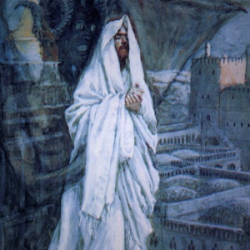 Reinventing a cinematic icon is a daunting task.
Reinventing a cinematic icon is a daunting task.
Ask George Lucas, who has been struggling to rehabilitate one of the silver screen's greatest villains for over thirty years. Or ask Stan Lee, whose Marvel characters are subjected to ill-conceived "reboots" on a nearly annual basis. Just don't ask Sylvain Chomet, the insane genius behind The Triplets of Belleville, whose recent animated feature, The Illusionist (L'illusionniste), makes it abundantly clear that reinvention is not only possible, but well worth the effort.
Based on a script from the legendary French director and comic Jacques Tati (whose cinematic alter-ego, Monsieur Hulot, appeared in a quartet of influential films during the 50's, 60's, and 70's), The Illusionist tells the story of The Great Tatischeff, an aging stage magician struggling to survive in a world increasingly disinterested in his threadbare sleight-of-hand. Dismissed from his most recent Paris engagement as a result of profound audience indifference, he embarks for the British Isles in a last-ditch effort to resuscitate his moribund career.
Coming briefly to rest in a tiny village pub on a small Scottish island, he acquires an unexpected follower: Alice, a credulous young char-maid who is convinced that his trite conjurings are truly magical. Unfortunately, her fellow townsfolk are less enamored than she is, and Tatischeff is obliged to head for the bright city lights once again. Unbeknownst to him, Alice follows along behind, aglow at the opportunity to accompany such a bewitching celebrity.
Upon arriving in Edinburgh and discovering his unexpected disciple, the magician grudgingly takes the young Alice under his wing, but the results are far from pleasant. Juggling his dwindling illusionary career with the practical jobs he must pursue in an effort to pay the bills that result from his new devotee's naïveté, Tatischeff is forced to confront his own social deficiencies.
The similarities between Tati's Hulot films—Les Vacances de Monsieur Hulot (1953), Mon Oncle (1958), Play Time (1967), and Trafic (1971)—and Chomet's most recent work are many. The character of Tatischeff himself, in addition to the obvious patronymic reference, is strikingly similar to Hulot in look, feel, and behavior, even down to the bemused, slightly awkward way in which he moves through the crowded city streets. Like Tati's films, The Illusionist is nearly entirely silent; dialogue, when it does occur, it is garbled and indistinct. For Chomet and Tati alike, inflection and mood are vastly more important to their storytelling than words. This lends an unusual—as in rare - Chaplinesque power to their images.
Chomet's unusual artistic genius was stunningly showcased by The Triplets of Belleville, but his tendency towards bizarre surrealism often overwhelmed the message he sought to convey. The Illusionist, on the other hand, is a quieter, more mature work—no doubt the result of Tati's subtly written characters and the mildly playful mood that permeates every frame of his films. While it retains much of the visual artistry of Triplets, the overall product is far more accessible.
Chomet's offering, however, breathes exciting new life into a dauntingly legendary icon, and in an extraordinary way: The Illusionist is deeply faithful to Tati's original characters and concepts, yet it advances the French master's ideas into unexpected and intriguing places.
The single overriding theme permeating all of Tati's work is the recognition of mankind's endless struggle against the sterilizing, dehumanizing effects of modern technology. Monsieur Hulot is the perfect representation of that struggle: a bumbling, gentle soul who can never quite understand why everything grows so angular, so noisy, and so paradoxically inefficient when compared to the old, reliable objects of his past. Yet Hulot is always more bemused than angered by this clash of eras. His films are mildly-worded admonitions and nostalgic reminiscences rather than harsh diatribes against impending danger. One almost feels that Tati recognized the futility of resisting technology's relentless march, and that his cinematic observations are more wistful than accusatory.
Chomet's work reflects much of the awkwardness and melancholy embodied by Tati's Hulot, clearly recognizing the corrosive effect of technology on the world of The Great Tatischeff. The growing disdain for the illusionist's time-honored skills is tied closely to the advent of more modern amusements. Tatischeff's departure from the small Scottish town, for example, is a direct result of the enormous electronic jukebox that appears at the local pub moments after his final performance. When the time comes for the illusionist to make the final fateful choice that will determine the course of his life for years to come, it is a decision thrust upon him by a society that grows more obsessed with shiny new gadgets than with the men who make them possible.





